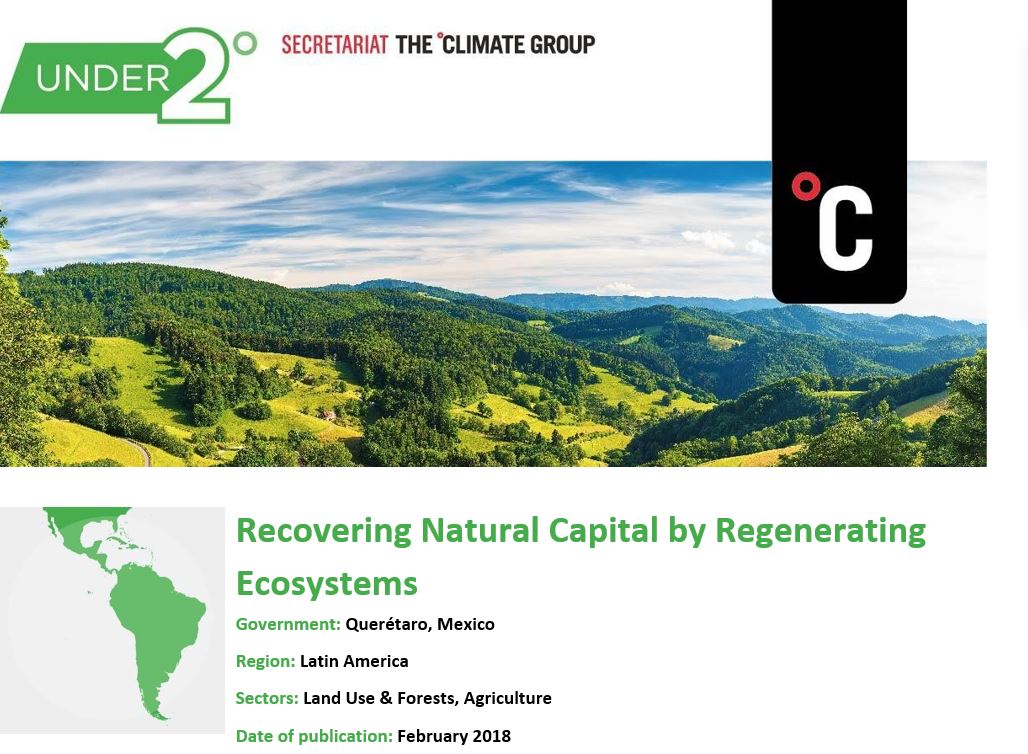Recovering Natural Capital by Regenerating Ecosystems
Summary
Forests cover more than one-third of the Mexican landscape.1These lands provide important cultural and ecological benefits, with Mexican forests containing one-tenth of the world’s biodiversity.2 They are carbon sinks, which absorb carbon dioxide from the atmosphere, helping to mitigate climate change. And they are also the main source of subsistence and commercial opportunity for the Mexican communities that own them. Between 1990 and 2005, Mexico lost about 7% of its forest cover (about 4.7 million hectares) as forests were converted to agricultural and livestock activities.3
Mexican lands dedicated primarily to livestock production cover a similar area.4 Managed improperly, these lands can be an important source of greenhouse gas emissions from the livestock themselves as well as from the degradation of soils. With regenerative management, however, grazing lands can be made both more profitable as well as important locations for greenhouse gas mitigation.
As the first Mexican state operating a local carbon mechanism, the State Government of Querétaro through its Secretary for Sustainable Development (SEDESU) promotes an initiative to re-green Mexico. It is a public policy that implements specific actions that enable mitigation and compensation of CO2 emissions, hence forming true carbon and water sinks in forests and on ranches. The established carbon tax at the sub-national level represents innovative financing that facilitates local solutions to the impossible rules of the global protocols for the local landowners.
Furthermore, Grupo Ecológico Sierra Gorda (GESG) has developed methodologies to monitor carbon sequestration in forests and soils, and tools for adaptation which can be applied to other states of the country and are available upon request.
Additionally, this component to replicate the model enables the transfer of regenerative tools, through training and technical assistance for forest owners, livestock producers, government officials, and technicians.
The need to support economic opportunities for Mexico’s rural communities, while also regenerating forests and soils, has led the state of Querétaro to support “payments for carbon footprint mitigation”, which provide monetary incentives to communities that remove cattle from their forests and adopt regenerative practices at their ranches, recovering ecosystem capacity and strengthening regional resilience.
The payments are funded by leveraging a federal matching fund where the State Government of Querétaro has accessed a 1 to 1 match with the National Forestry Commission (CONAFOR) based on the proceeds from a carbon tax that Querétaro state has placed on private vehicles, and it does not go to the federal Finance Ministry but rather operates on a sub-national level.
In addition to forest restoration, the project also promotes regenerative practices such as hydrological key-line design and holistic planned grazing by training technicians, students, and ranchers in carbon farming. Now, with Querétaro State´s Secretary of Agricultural Development, clear steps have been taken to incorporate these activities in the public policy agenda, so soil regeneration practices are reinforced institutionally.
In addition to increasing productivity for the ranchers, the project managers at GESG are currently working to generate carbon offset credits from the project though the American Carbon Registry’s Grazing Land and Livestock Management Methodology. They are working with large ranches that fulfill the necessary criteria to develop credits for the regulated market.
Results
While the project is just getting underway, the pilot projects for both the forest restoration and planned grazing components have been successful. Forest restoration through “payments for ecosystem services” has been implemented for several years in the old growth oak forests of the Sierra Gorda by GESG in partnership with Bosque Sustentable A.C. (BSAC), and currently provides payments for the preservation of approximately 6,000 hectares each year. Similarly, the planned grazing component began as a pilot project on approximately 82,000 hectares in the states of Querétaro, San Luis Potosí, Chihuahua, and Sonora.
If these activities are successfully expanded through the application of a Nationally Appropriate Mitigation Action (NAMA) operated by GESG, including expansion in existing states and replication in additional Mexican states, GESG estimates that the forest restoration component will restore 338,000 hectares, reducing Mexico’s greenhouse gas (GHG) emissions by 2.47 MtCO2e over five years, with the planned grazing component regenerating 788,000 hectares, and reducing 7.2 MtCO2e during the five years.
Anecdotally, Sierra Gorda ranchers have said that their participation in the pilot projects, including the trainings by GESG, have increased their income and improved their cattle’s overall health.5
Challenges
According to Martha “Pati” Ruiz Corzo, Director and co-founder of GESG, one of the main challenges are the global protocols, which were not aligned with local realities and are costly to implement. The solution in this project was to work directly with the government of the state of Querétaro to secure the needed financing and also to help meet state goals, such as offsetting GHG emissions from the state’s vehicle fleet.
Lessons learned
The keys to the success of the project include providing monetary incentives to landowners through “payments for reduction of emissions” that operate under a very reliable Monitoring, Reporting and Verification system. The local protocol is undergoing validation by ICAT as an early adopter for transparency in public policies. Without these monetary incentives, the landowners would understandably seek other commercial opportunities for their land.
Incorporating soil and forest regeneration tools will recover the natural capital. This is an emerging action to fight and adapt to climate change and recover natural infrastructure, strengthening its carbon and water capture services. The biodiversity will have sanctuary and the healthy food production will be strengthened. By operating this model on a large scale, re- greening Mexico, on-going civic participation will gain the buy-in of rural communities.
More information
For more information on the project, visit here.
For more information on “payments for ecosystem services,” visit here. For more information on “holistic planned grazing,” visit here.
For more information on Grupo Ecológico Sierra Gorda, visit here.
Contact: Martha “Pati” Ruiz Corzo, Director, Grupo Ecológico Sierra Gorda, sierragordareserve@yahoo.com


 Roberto Pedraza Ruiz
Roberto Pedraza Ruiz